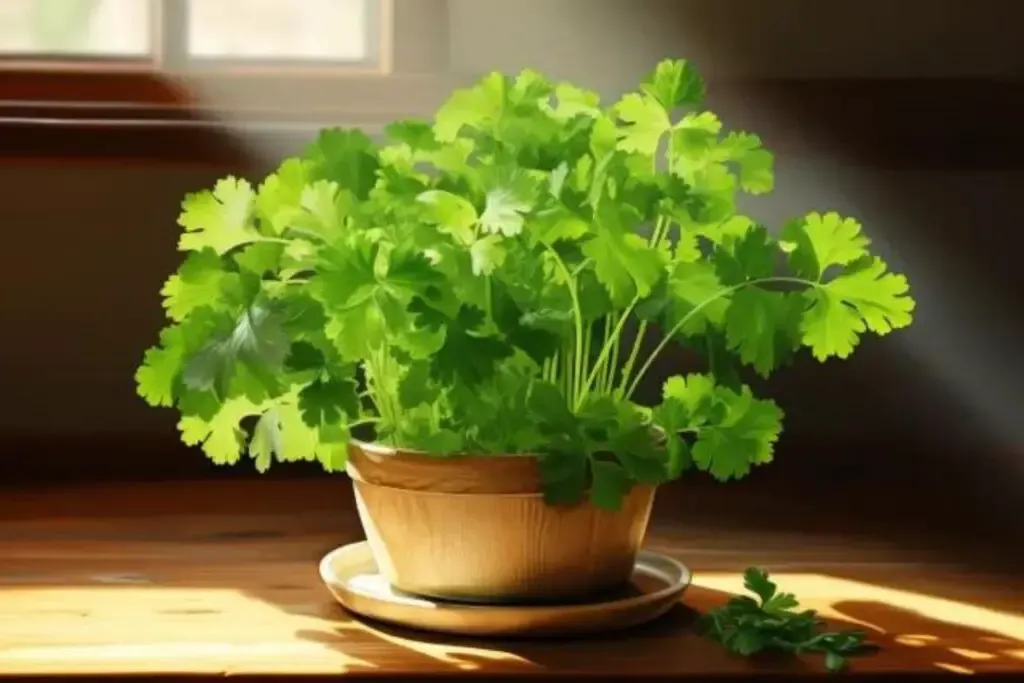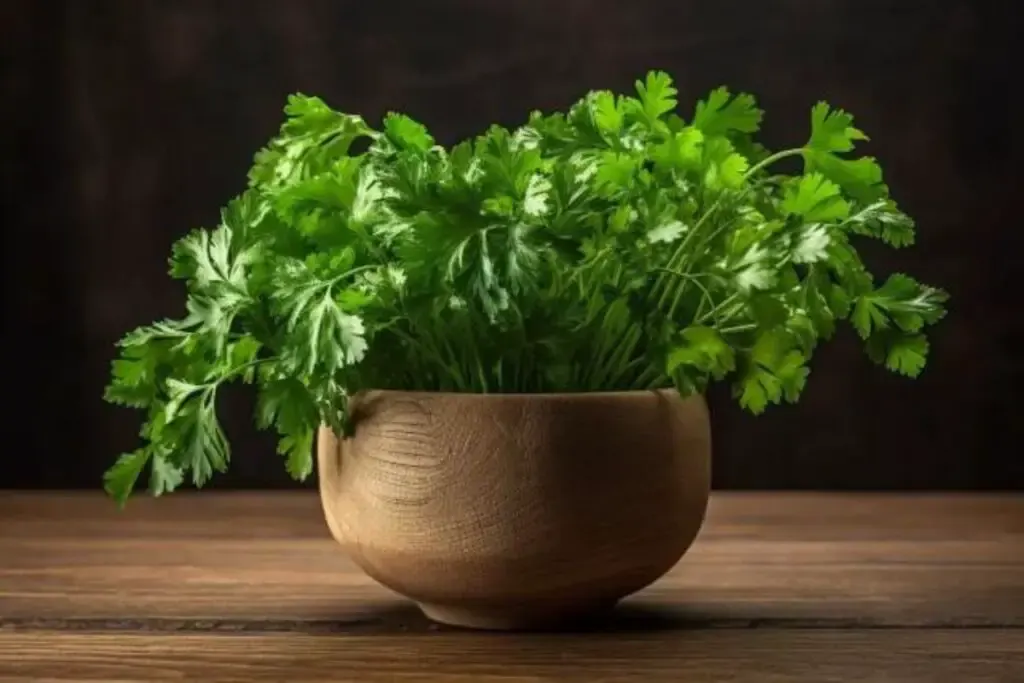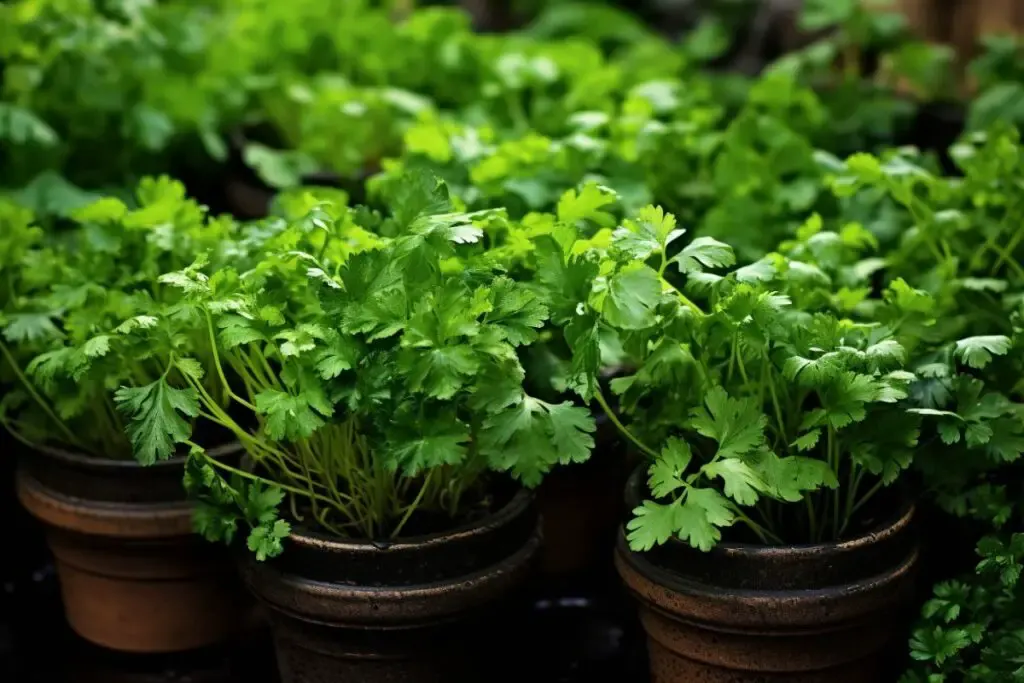Parsley, the humble herb that graces dishes with its fresh, vibrant flavor, isn’t just limited to sprawling garden beds.
This versatile greenery is just as happy to flourish in the cozy confines of a pot or container, making it a fantastic choice for those with limited space or an affinity for balcony gardening. But how does one transition from a casual grower to a parsley-potting expert?
Let’s dig into the nitty-gritty of container gardening with this culinary staple.
Does Parsley Grow Well in Pots?
The short answer is an emphatic yes! Parsley is one of those agreeable herbs that adapt well to the boundaries of a pot, given the right conditions.
The key to success lies in the pot’s size, the soil quality, and the care you lavish upon it. When grown in pots, parsley’s roots stretch down and around the container, snug but not too constricted, which can actually encourage a more concentrated flavor in the leaves.
As an avid gardener myself, I’ve found that potted parsley not only saves space but can also be moved around to take advantage of the best growing conditions throughout the season.
A pot of parsley on your kitchen windowsill or balcony is not only convenient for snipping fresh sprigs as you cook but it also brings a spritz of green life into your home.
Best Parsley Varieties for Pots
When selecting parsley for pot culture, there are a few champion varieties that come to mind.
Each has its own unique characteristics, from flavor profile to leaf shape, and I’ve grown each of these with success in my own container garden.
1. Flat-leafed (Italian) Parsley

Flat-leafed parsley, often referred to as Italian parsley, is a culinary darling for a good reason. It boasts a robust, slightly peppery flavor that holds up well during cooking, making it a preferred variety for chefs and home cooks alike.
It’s also relatively resistant to bolting (going to seed) in hot weather, which is a plus for gardeners contending with warmer climates.
In pots, flat-leaf parsley’s deep green, flat leaves make for an attractive and lush addition to your collection of herbs. I always recommend starting with this variety for those new to potted herbs due to its forgiving nature and versatile use.
2. Curly Leaf Parsley

Curly leaf parsley is what many imagine when they think of this herb, with its bright green, ruffled leaves that make a beautiful garnish. While some may argue that it’s milder in flavor than its flat-leafed cousin, it still packs a punch in the kitchen.
This variety is not only delightful on the palate but is visually stunning in a pot, adding texture and volume that can complement other plants or stand out on its own. Its compact growth habit makes it well-suited to container life, where it can be clipped regularly to maintain a dense, bushy shape.
3. Hamburg Parsley

Hamburg parsley is a bit of an outlier, sporting a dual-purpose nature. It’s grown not only for its flavorful leaves but also for its large, edible root, which can be used much like a parsnip.
When grown in pots, ensure the container is deep enough to accommodate the root development. This variety might require a bit more attention to ensure the soil is rich and well-draining, but the payoff is twofold: you get both a herb and a root vegetable in one pot!
From personal experience, Hamburg parsley brings a unique aspect to container gardening, with its earthy flavor and the added excitement of harvesting both above and below the soil.
How to Grow and Care For Parsley in Pots
Mastering the art of growing parsley in pots isn’t just about choosing the right variety; it’s also about giving your plants the care and attention they need to thrive.
Let’s walk through the key steps to ensure your potted parsley becomes a lush, leafy, flavor-packed powerhouse.
Planting
When planting parsley in pots, timing is everything. I like to start my seeds indoors about 6-8 weeks before the last spring frost date.
Parsley seeds can be notoriously slow to germinate, sometimes taking up to 3-4 weeks, so don’t despair if you don’t see sprouts immediately.
Soaking the seeds overnight can speed up the process. Once they sprout, I wait until they have a few true leaves before transplanting them to their pot.
Pot Size
Choosing the right pot size is crucial. Parsley doesn’t need a deep pot, but it does require room for its taproot to grow.
I recommend a pot that’s at least 8-10 inches deep and wide, with ample drainage holes at the bottom. A too-small pot will restrict growth, leading to a less-than-bountiful harvest.
Light
Parsley loves the sun but appreciates a break from the heat. I’ve found that placing pots in a spot that gets 6-8 hours of sunlight, followed by partial shade during the hottest part of the day, yields the best results.
If you’re growing parsley indoors, a sunny windowsill that gets plenty of light will suffice.
Soil
The right soil can make all the difference. Parsley prefers rich, loamy soil that drains well. I like to mix in plenty of organic matter, like compost, which not only helps with drainage but also provides essential nutrients.
A good quality potting mix specifically designed for containers is your best bet.
Water
Consistent moisture is key to keeping parsley happy, but overwatering can be just as detrimental as letting the soil dry out.
I water my parsley when the top inch of soil feels dry to the touch. It’s a simple finger test that’s served me well over the years.
Temperature and Humidity
Parsley is a cool-season herb that enjoys moderate temperatures and can even tolerate a light frost. That being said, it doesn’t do well in extreme heat or cold.
Aiming for a temperature range of 70-85°F during the day and no lower than 50°F at night is ideal. As for humidity, parsley isn’t too picky, but if the air is very dry, occasional misting can help.
Fertilizer
While parsley isn’t a heavy feeder, it does benefit from occasional fertilization. I feed my plants with a half-strength balanced liquid fertilizer every 4-6 weeks during the growing season.
It’s important not to overdo it, as too much fertilizer can lead to lots of lush leaves with diminished flavor.
Pruning Potted Parsley
Pruning isn’t just about keeping your plants looking tidy; it’s also a key step in promoting healthy growth and prolonging harvests. When it comes to parsley, regular pruning encourages fuller, bushier plants, and who doesn’t want more of those delectable leaves?
When I prune parsley, I use a simple rule: the “one-third” rule. Never remove more than one-third of the plant at any one time. This ensures the plant has enough foliage to continue photosynthesis, which is essential for growth.
I focus on snipping stems just above leaf nodes, which stimulates new growth. Also, always use a sharp pair of scissors or pruning shears to make clean cuts that heal quickly.
And remember, the more you harvest parsley, the more it grows. So don’t be shy about snipping those sprigs for your kitchen needs. Just be consistent and gentle in your approach, and your parsley will thank you with a bountiful yield.
Overwintering
If you’re in a region where winters are mild, you may not need to overwinter your parsley at all. But in cooler climates, overwintering is a useful technique to protect your plants from the cold and give them a head start in spring.
To overwinter parsley, I begin by cutting back the plant to about 2 inches above the soil line after the first frost, which helps to encourage new growth in the spring.
If you have outdoor pots, you can move them to a sheltered spot like under a deck or inside a garage where they’re protected from wind and severe temperatures. For additional insulation, I sometimes wrap pots with burlap or bubble wrap.
For parsley that’s staying outdoors, mulching with straw or leaves can provide extra warmth. And, if you’re bringing pots inside, make sure they’re placed in a cool, bright space and water them sparingly throughout the winter. Parsley is semi-dormant during this time and won’t need much moisture.
The goal with overwintering is to keep your parsley plants alive but dormant. Then, when the warmth of spring returns, they’ll be ready to jump back into vigorous growth, giving you a head start for the season’s cooking adventures.

